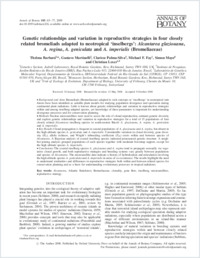Genetic relationships and variation in reproductive strategies in four closely related bromeliads adapted to neotropical ‘inselbergs’: Alcantarea glaziouana, A. regina, A. geniculata and A. imperialis (Bromeliaceae)
- Barbará, Thelma Genetics Section, Jodrell Laboratory, Royal Botanic Gardens, Kew, UK
- Martinelli, Gustavo Instituto de Pesquisas, Jardim Botânico do Rio de Janeiro, Brazil
- Palma-Silva, Clarisse Laboratório de Genética Molecular Vegetal, Departamento de Genética, IB/Universidade Federal do Rio Grande do Sul, Porto Alegre, Brazil
- Fay, Michael F. Genetics Section, Jodrell Laboratory, Royal Botanic Gardens, Kew, UK
- Mayo, Simon Monocots Section, Herbarium, Royal Botanic Gardens, Kew, UK
- Lexer, Christian Genetics Section, Jodrell Laboratory, Royal Botanic Gardens, Kew, UK - Unit of Ecology & Evolution, Department of Biology, University of Fribourg, Switzerland
-
2008
Published in:
- Annals of Botany. - 2009, vol. 103, no. 1, p. 65-77
English
Background and Aims: Bromeliads (Bromeliaceae) adapted to rock outcrops or ‘inselbergs’ in neotropical rain forests have been identified as suitable plant models for studying population divergence and speciation during continental plant radiations. Little is known about genetic relationships and variation in reproductive strategies within and among inselberg-adapted species, yet knowledge of these parameters is important for understanding divergence processes and for conservation planning.Methods: Nuclear microsatellites were used to assess the role of clonal reproduction, estimate genetic diversity and explore genetic relationships and variation in reproductive strategies for a total of 15 populations of four closely related Alcantarea inselberg species in south-eastern Brazil: A. glaziouana, A. regina, A. geniculata and A. imperialis.Key Results: Clonal propagation is frequent in coastal populations of A. glaziouana and A. regina, but absent in the high-altitude species A. geniculata and A. imperialis. Considerable variation in clonal diversity, gene diversity (He), allelic richness, and Wright's inbreeding coefficient (FIS) exists within and between species of Alcantarea. A Bayesian analysis of coastal inselberg species indicated pronounced genetic structure. A neighbor-joining analysis grouped populations of each species together with moderate bootstrap support, except for the high altitude species A. imperialis.Conclusions: The coastal inselberg species A. glaziouana and A. regina tend to propagate asexually via vegetative clonal growth, and both reproductive strategies and breeding systems vary greatly between populations and species of Alcantarea. The microsatellite data indicate a history of hybridization and reticulation involving the high-altitude species A. geniculata and A. imperialis in areas of co-occurrence. The results highlight the need to understand similarities and differences in reproductive strategies both within and between related species for conservation planning and as a basis for understanding evolutionary processes in tropical radiations.
- Faculty
- Faculté des sciences et de médecine
- Department
- Département de Biologie
- Language
-
- English
- Classification
- Botany
- License
-
License undefined
- Identifiers
-
- RERO DOC 11249
- DOI 10.1093/aob/mcn226
- Persistent URL
- https://folia.unifr.ch/unifr/documents/300962
Statistics
Document views: 183
File downloads:
- Fichier principal: 210
